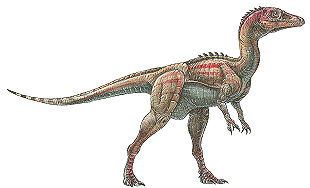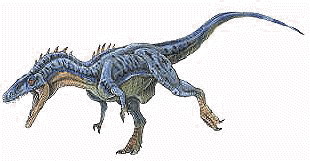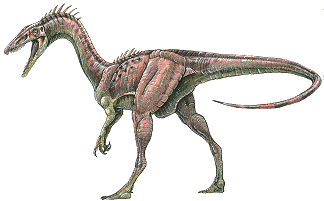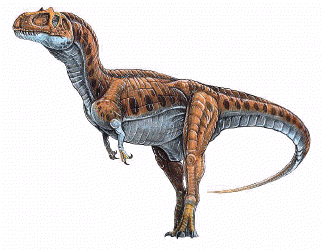|
|
 |
|
Introduction to Tyrannosaur Evolution |
|
Below are the images
and information that appears in the inset titled "Tyrannosaur
Ancestors" located in the upper left corner of the poster. These
species are early meat-eaters that later evolved into the
tyrannosaurs. Note their similarities to their famous
descendents. The are bipedal; they walk on their powerful hind
legs and use their heavy tails to maintain balance. Their
forearms are short and comparatively weak. All have small heads.
The massive heads of the tyrannosaurs will develop later.
Their is a page devoted to each species, which provides more
detail. The primary purpose of this page is to show all of them
together in chronological order. |
 |
Eoraptor
228 million years ago
Name Means: "Dawn Thief"
Pronounced: EE-o-rap-tor
Fossils found: Northwest Argentina, Madagascar
Eoraptor is one of the earliest dinosaurs and its success as a
hunter helped determine the survival of the species. An almost
complete skeleton was discover in 1993. It has increased science
knowledge of how dinosaurs developed and evolved. Eoraptor
had the characteristics of later dinosaurs - serrated teeth,
grasping hand, light hollow bones and a strong, light skull.
Unlike many later dinosaurs, it had five fingers. |
 |
Herrerasaurus
225 Million years ago
Name Means: "Herrera's Lizard"
Pronounced: huh-Rare-uh-Sore-us
Fossils found: San Juan Province, northwestern
Argentina
This is one of the oldest dinosaurs ever found and is one of
the three found in South America that represent the earliest of
form of meat-eating dinosaurs. Unlike later dinosaurs, it ate many
things including lizards, amphibians and possibly insects.
Its teeth are more conical in shape than later or contemporary
dinosaurs and they have serrations like later carnivores |
 |
Coelophysis
220 million years ago
Name Means: "Hollow Form"
Pronounced: SEE-low-FIE-sis
A very common little hunter of the Late Triassic, Coelophysis came
in two forms "robust" and "gracile" which may represent the two
genders. Because it was so small Coelophysis probably
traveled and hunted in herds. It had a long flexible neck
and tail and walked upright on its strong birdlike hind legs.
It front limbs ended in three clawed fingers that could grab and
tear prey |
 |
Eustreptospondylus
161-159 million years ago
Name Means: "Well Reversed Spine"
Pronounced: u-Strep-toe-spon-Di-lus
Fossils found: Oxford, England |
| |
|
| |
|
|
|
|
| |
|
|
|
|
| |
|
|
|
|
|
|
|
|
Edugraphics.Net | Feenixx Publishing |
|
|
|
|
|




